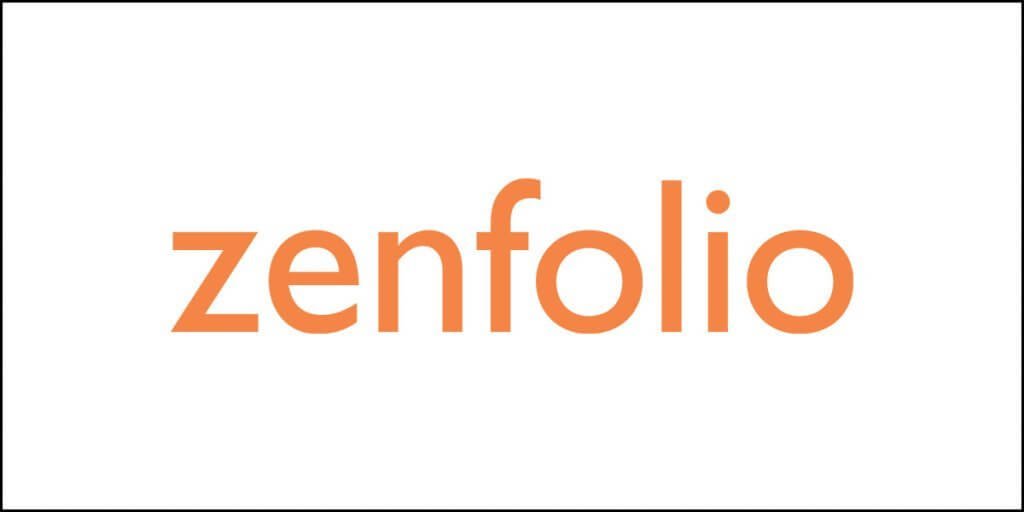Email marketing is without a doubt one of the most effective methods for companies to boost website traffic and income.
According to Statista.com, about 300 billion emails will be sent and received globally each day in 2020. Additionally, 87% marketers utilize email marketing to disseminate their business’s content, according to the most recent statistics. To my mind, they are some very lofty numbers.
Whether you’ve recently started your company or have been around for a while (and still expanding), you’re undoubtedly aware of the value of email marketing.
Manual email newsletters, on the other hand, need a great deal of time, effort, and resources. Even though this is a necessary component of your company, scaling an email marketing campaign without some kind of automation is difficult. This is where autoresponders come to the rescue.
Autoresponders enable you to send automatic emails to customers in response to specified actions, such as subscribing to your email list or making a purchase. Additionally, responders may be used to construct email sequences depending on certain rules, circumstances, or triggers.
What Makes an Excellent Free Autoresponder Tool?
While many email marketing platforms provide free plans, some may not have automation or autoresponder capabilities. Rather than that, consumers get access to these critical marketing tools when upgrading to a free plan. However, several ESPs (Email Service Providers) provide autoresponder features as part of their free programs.
The following are the primary characteristics that the finest free autoresponder tools should have:
- A straightforward email editor for autoresponders, transactional emails, and newsletters.
- Subscriber information is collected via popups and signup forms.
- A visual builder for workflow that includes templates for common automation processes such as birthday replies, welcome series emails, and transactions on e-commerce websites.
- Customer processes that are customized for each subscriber group based on their most frequently visited pages and activities on the website.
- List management via customization and segmentation.
- Users may see detailed statistics and analytics on the effectiveness of their email sequences and automation programs.
- A/B testing is used to ensure that messages are optimized far in advance of their distribution.
- Automation for e-commerce communications such as abandoned cart recovery, order alerts, and product suggestions.
- Landing pages to maximize the possibility for new subscription acquisition.
- Links to social networking sites enable users to share information with their contacts immediately.
Okay, now that you know about a few tidbits, it is time to take a close look at the 8 best autoresponder tools for 2025. To clarify, the list is not segregated into free and paid tools.
In fact, there are not such absolutely free tools. All paid options have a free tier that you can use. Once that free limit is over, you can wait until the free limit is restored, or you can upgrade to a paid plan.
At the end of the list, I will answer some of the most important questions related to autoresponders and email marketing in general.
It is going to be a long read, and so, gear up!
#1. MailChimp
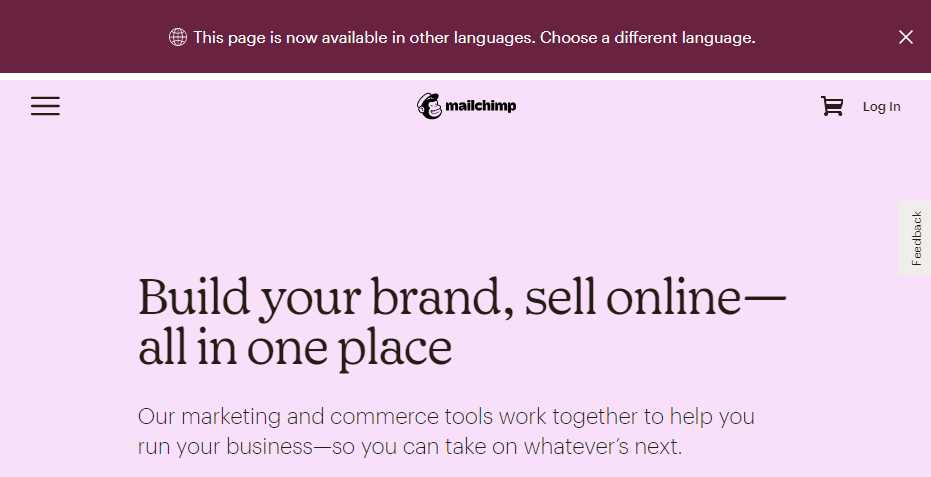
MailChimp is without a doubt the most popular email marketing tool available today. Through its varied templates and sophisticated automation capabilities, this email marketing platform assists small companies in capturing email leads and engaging with their audience.
MailChimp includes all of the essentials, such as anniversary emails, welcome messages, and customer journey processes, but also sophisticated capabilities such as social network postings, automated digital advertising, retargeting, and even postcards.
However, its primary emphasis is in the digital realm. Autoresponders of MailChimp are mostly based on behavior. As a result, users may create rules to send follow-up emails in response to behavioral signals such as email sign-ups and abandoned carts.
While MailChimp’s free plan includes integrations to seven marketing channels that users may automate, the marketing autoresponders themselves only support one-step automations. This limits users to creating just straightforward messages and sequences for their list.
MailChimp Primary Features:
- Advanced analytics
- Automated drip campaigns
- Contact management and contact segmentation
- Time zone-based delivery
- Email editor with drag-and-drop feature
- Email support and live chat support
- Landing pages
- Marketing automation options
- Marketing CRM
- Multivariate testing
- Pre-built form templates
- Predicted data insights
- Send time optimization
- Social media marketing
Best Suited For:
Perfect for individuals and SMBs.
Advantages of Using MailChimp:
- Users of the free plan of MailChimp may create basic autoresponders. It’s ideal if you’re looking for a little amount of automation.
- The user interface is simple and intuitive.
- MailChimp’s autoresponders include those for behavior-based automation, welcome sequences, RSS-to-email sharing, and date-based mailings.
- MailChimp also has e-commerce systems that automate the sending of messages about order notifications, about abandoned carts, and payment confirmations, among other things.
- MailChimp includes customer loyalty processes for product follow-ups and re-engagement.
- MailChimp provides a tool that assists customers in identifying their target audience by comparing them to comparable audiences in the same sector. This enhances users’ strategies for future marketing.
- The built-in live previewer enables users to see how the emails will appear on various devices before they send them.
- MailChimp connects to more than 300 third-party applications, including Help Scout, Canva, WordPress, and EventBrite.
Disadvantages of Using MailChimp:
- MailChimp’s premium plans may quickly become prohibitively costly as a user’s list gets larger.
- With the free plan, MailChimp’s branding will appear on the emails you send.
- You will not be able to build a multi-step autoresponder series if you are using MailChimp’s free plan.
- MailChimp’s autoresponders do not include a visual workflow editor. This may result in users being perplexed while controlling their autoresponder series.
- MailChimp users cannot build new automations, and the existing pre-built automation processes are restricted.
- MailChimp emails commonly appear in the Promotions tab of Gmail, rather than the main inbox.
- Email assistance is included in the free plan for the first 30 days. Following that, you’ll only have access to knowledge base materials to assist you in resolving your issues.
- While MailChimp’s autoresponder capabilities are excellent, they fall short of the strength of its rivals.
MailChimp Free Plan:
The free plan allows the following:
- 10,000 emails every month.
- Maximum of 2000 subscribers.
If your subscriber count remains below 2000 for a long time, you can continue using MailChimp for free. For a list beyond 2000 subscribers, you must upgrade to a paid plan. The starting price for the paid plans is $9.99 every month.
#2. Sendinblue
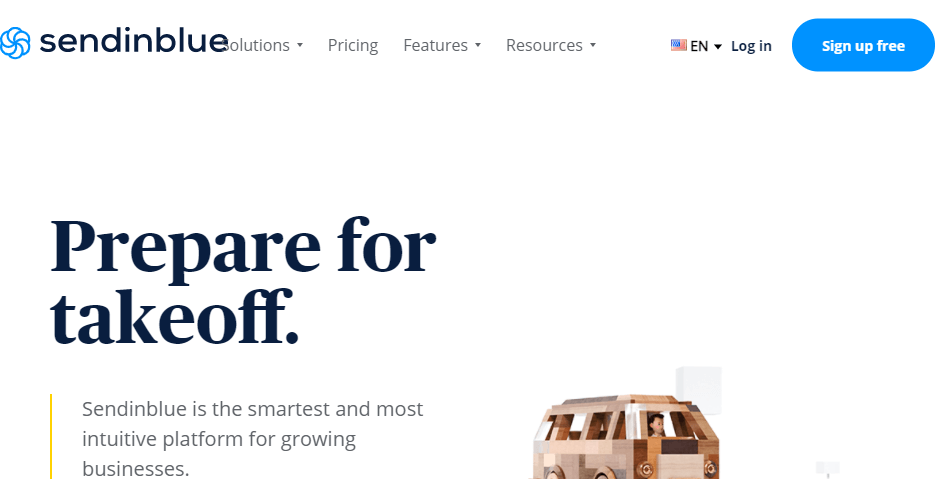
Sendinblue is a marketing automation platform that is trusted by over 80,000 people and companies. It includes everything you need to connect with your audience, customize your messages, convert visitors to leads, and create money. If you’re looking for an all-in-one email marketing solution that can automate live chat, SMS marketing, and email marketing, Sendinblue has you covered.
Email automation is fairly easy and transparent with Sendinblue. This transactional email service includes some rather sophisticated autoresponders as part of their free lifetime plan (which is shocking given their low price), including those triggered by customer actions like site events, abandoned carts, purchases, etc. If you have purchased SMS credits, you may include text messages or SMS in your autoresponder campaign. By itself, this certainly qualifies it as one of the finest free email autoresponder programs available.
A workflow builder is available that includes conditions and rules depending on client behavior. In a visual editor, you may modify the autoresponder campaign and connect to a variety of automatic messages. If you choose not to build a unique campaign, you may choose from a variety of templates ranging from the simple one like birthday messages to the complex ones like lead scoring.
Sendinblue Primary Features:
- A robust template library
- A/B testing
- Automated and highly effective marketing campaigns
- Contact segmentation
- Customer management
- Editor with drag-and-drop feature
- Email heat maps
- Free sales CRM
- GDPR compliance
- Landing pages
- Lead management
- Options for email marketing
- Real-time reports and statistics
- Send-time optimization
- Sign-up forms
- SMS marketing
- Social media adverts
- Third-party app integration
- Tools for ads retargeting
- Transactional emails
Best Suited For:
Perfect for ecommerce businesses and SMEs.
Advantages of Using Sendinblue:
- If users encounter any difficulties, they may contact Sendinblue’s customer service through email.
- Prior to starting a process, users may test it.
- Sendinblue connects to a broad variety of third-party apps, including Shopify, WooCommerce, and Salesforce.
- Sendinblue customers may now send SMS using the service.
- The free for life subscription includes access to the majority of Sendinblue’s capabilities, including autoresponder.
- The graphical user interface is simple and straightforward.
- The tool for marketing automation has a simple interface with a drag-and-drop feature.
- There are many templates to choose from. Additionally, users may build their own unique template or upload their own HTML template.
- Through the SMTP protocol, users may send transactional emails.
- Unlimited contacts are included in the free plan.
- Users can successfully nourish their leads with the help of the lead score system.
Disadvantages of Using Sendinblue:
- In case you are using the free plan of Sendinblue, all of your emails will have the Sendinblue logo. Unless you decide to upgrade to a premium plan, you cannot remove the logo.
- The permanently free plan limits you to 300 emails each day, which may be inconvenient for people with bigger mailing lists.
- Only the Premium subscription plan and the Enterprise subscription plan of Sendinblue enable customers to establish numerous logins.
- Reports generated by Sendinblue exclude information on social media and sales conversions.
- While the free plan provides for an infinite number of contacts, an autoresponder campaign may only be sent to 2,000 contacts. Once you upgrade to a premium plan, this restriction will be removed.
Sendinblue Free Plan:
The free plan of Sendinblue offers the following:
- Allows an infinite number of contacts in your mailing list.
- Allows sending only 300 emails every day.
- Allows sending autoresponder campaigns to only 2,000 contacts.
Just in case the free plan is not sufficient for your needs, you can upgrade to one of their paid plans that start from $25 per month.
#3. Moosend
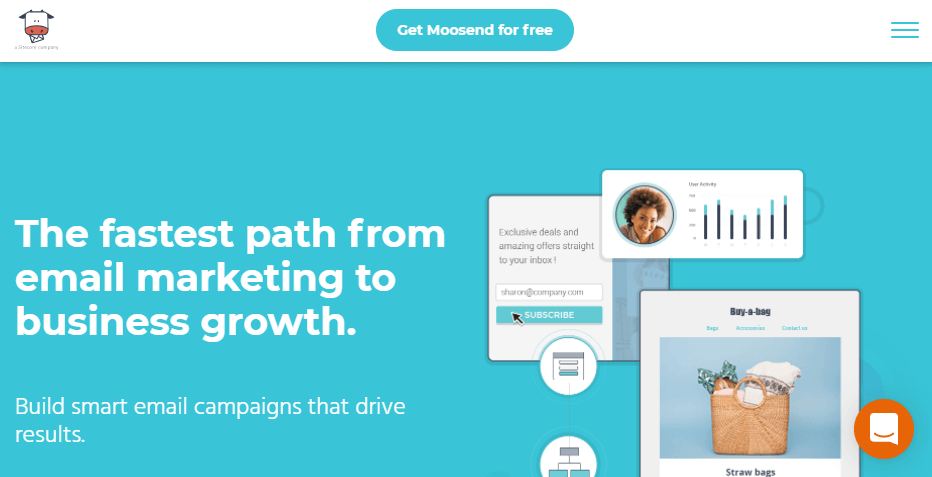
Moosend was founded in 2013 as an email marketing platform. It enables company owners and marketers to automate their email marketing chores, thereby giving them the scope to concentrate on developing strong connections with their audience. If your company is quickly expanding and you’re searching for a reliable email autoresponder that can scale as your needs grow, Moosend is an excellent option. It offers a robust free plan, while the premium plans are cheap for small companies and feature rich.
While Moosend is not as well-known as MailChimp or MailerLite, companies such as Domino’s and Gucci rely on it to help them grow their operations. Moosend provides companies with everything they need for engaging and nurturing their audiences from the moment they sign up. They platform offers a powerful and insanely simple drag-and-drop email editor, and it even allows performing A/B split testing.
Moosend is a visually appealing drag-and-drop email builder with pre-built themes. You can customize and monitor your emails. Additionally, there is a slick and simple-to-use editor for workflow automation.
The workflow possibilities are almost limitless. They contain the fundamental welcome emails and anniversary emails, as well as more sophisticated features like user onboarding and lead capturing. Additionally, e-commerce businesses benefit from features such as upselling emails, abandoned cart automation, and VIP offers.
Moosend Primary Features:
- Advanced personalization
- Advanced reports
- Allows A/B split testing
- API access
- Autoresponders
- Behavioral analytics
- Contact management
- E-commerce AI
- Email editor with a drag-and-drop interface
- GDPR compliance
- Integration with 100+ third-party apps
- Landing pages
- List segmentation
- Prebuilt templates and landing pages
- Product recommendations
- SPAM test
- Templates for email automation
- Transactional emails
- Unique tools for marketing automation
- User tracking
- Visual automation editor
- Weather-based recommendations
- Website tracking
Best Suited For:
Moosend is a great solution for entrepreneurs and SMBs looking for a reliable email marketing solution and an autoresponder tool.
Advantages of Using Moosend:
- The user interface is straightforward and simple to navigate.
- The free plan includes the majority of the features included in the premium plans.
- Users may see detailed statistics on every step a client takes on their site.
- The reporting capabilities include one-of-a-kind sub-functions such as real-time tracking, local tracking, and PDF export.
- Moosend enables hyper-personalization or broad targeting by using artificial intelligence to ascertain user tastes and interests.
- Despite using the free plan, Moosend members may opt out of having their branding appear in emails.
- Users have the ability to build an infinite number of data fields and custom segments.
- In comparison to many of the rivals, Moosend’s autoresponders and automated processes are powerful.
- Moosend connects to a broad variety of third-party applications, including Magento, Salesforce, and WooCommerce.
- Moosend provides a vast knowledge base, comprehensive video lessons, and unmatched customer support.
Disadvantages of Using Moosend:
- As opposed to other players in the market, Moosend integrates with a restricted number of third-party apps.
- Moosend does not have native SMS capabilities.
- The free plan does not have the ability to send transactional emails or create landing pages.
- Because Moosend’s design is distinct from that of Gmail, users must switch between the two, which may be time consuming and confusing.
- The free plan’s customer assistance is limited to five days per week and excludes phone help.
- There is currently no mobile application for Moosend.
Moosend Free Plan:
The free plan of Moosend offers the following:
- 1000 subscribers.
- Unlimited mails.
If these limitations are not enough, or if you want to send transactional emails or create landing pages, you must upgrade to one of their paid plans that start from $8 a month.
#4. HubSpot Email Marketing Tools
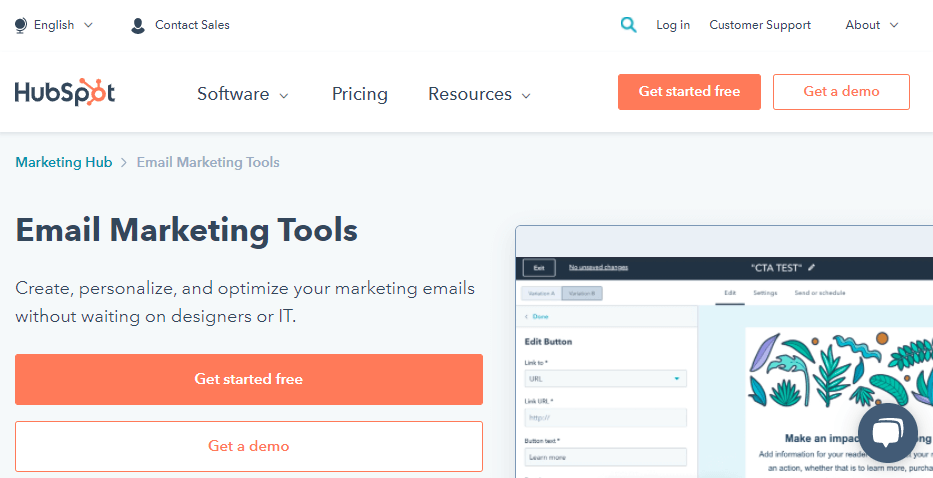
HubSpot was founded in 2006 and the company is a pioneer of inbound marketing. HubSpot offers a highly adaptable growth platform. This firm assists companies in developing and measuring effective marketing strategies. This is accomplished by providing companies with all of the tools required to manage their social media, blogging, website analytics, and email marketing efforts in a single fully featured package.
HubSpot provides five main products: Marketing Hub, Operations Hub, Content Management System (CMS) Hub, Service Hub, and Sales Hub, all of which help companies operate more efficiently. HubSpot introduced an entirely free email marketing platform in 2019.
This platform includes basic email autoresponder capabilities in addition to a CRM. Users have the option of automating a single email. This series may be triggered in a variety of ways, such when a client completes a registration form, interacts with emails and advertisements, or visits a product page.
Users may use any condition or trigger they wish and construct as many steps as they prefer in creating their ideal sequences. Additionally, HubSpot Marketing Hub is very versatile, allowing users to schedule automations to run for a certain amount of time or just during specific email campaigns.
HubSpot Email Marketing Tools Primary Features:
- A/B split testing
- Ad’s retargeting
- Autoresponders
- Comprehensive analytics
- Contact site activity data
- Customizable email templates
- Email editor with a drag-and-drop interface
- Email tracker
- Integration with third-party apps
- Landing pages
- Lead generation and lead management
- List segmentation
- Management of sales pipeline
- Meeting scheduler
- Options for marketing automation
- Signup popups and forms
Best Suited For:
HubSpot Email Marketing Tools are best suited for small businesses, startups, and SMEs.
Advantages of Using HubSpot Email Marketing Tools:
- The user interface is simple and straightforward.
- Because HubSpot is a cloud-based platform, users can access it from any device.
- Users may see how their contacts interact with content. HubSpot encourages users to establish attainable business objectives.
- HubSpot Marketing Hub may be integrated with either Salesforce or HubSpot CRM to ensure that all contact information is captured.
- Users may tailor their marketing efforts in order to maximize the effectiveness of marketing campaigns they launch.
- Users may contact HubSpot support through live chat, email, or phone depending on the package they are using.
- Users may evaluate the return on investment of their inbound approach using closed loop reporting.
Disadvantages of Using HubSpot Email Marketing Tools:
- HubSpot Marketing Hub may be very costly, particularly if you do not use all of the capabilities.
- For bigger companies with sophisticated sales processes, HubSpot’s functionality may be restricted.
- The less expensive versions do not include A/B split testing.
- In comparison to other free autoresponder options on the list, the email templates are rather restricted.
- Technical assistance is a paid service.
HubSpot Email Marketing Tools Free Plan:
HubSpot Email Marketing Tools are entirely free. You need to pay a dime for using them. However, if you want to use advanced features offered by HubSpot Marketing Hub, you must get a paid plan for Marketing Hub, the price of which starts at $50.
#5. Constant Contact
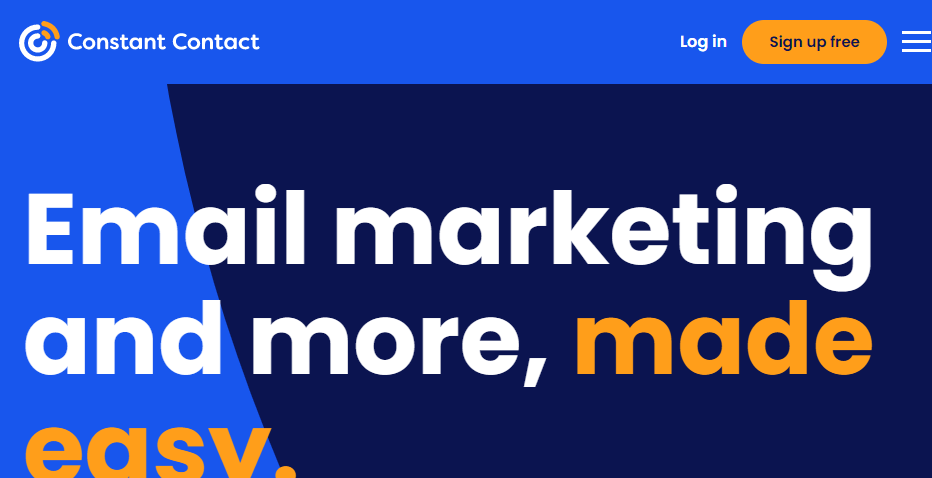
Constant Contact, founded in 1998 and accepted by more than 600,000 companies and marketers worldwide, is a robust email marketing system that enables small businesses and non-profit organizations to expand their audience and income via email marketing and social media advertising. Constant Contact offers more than just email marketing. It also offers tools for surveys, social media marketing, discounts, and events.
While this email service provider is technically not a free email autoresponder or an email marketing software due to the lack of a free plan, it does provide a generous 60-day free trial. Additionally, Constant Contact offers over 100 templates optimized for mobile devices that customers may customize using the drag-and-drop editor. Users with programming skills may build their own email templates. Additionally, there is a function that scans a user’s website and generates a template that matches the brand colors of the business.
Constant Contact’s marketing automation capabilities enable customers to send a series of customized emails to subscribers in an autoresponder series, as well as repeat emails to subscribers who did not read the original email. Additionally, users may send customized birthday emails, welcome emails, and anniversary greetings.
Constant Contact Primary Features:
- A/B split testing
- An editor with a drag-and-drop interface
- Autoresponders
- Customizable CTAs
- Data segmentation using tags
- Great options for marketing automation
- High deliverability rates
- Integrations with third-party apps
- Polls and Surveys
- ROI tracking
- Social media campaigns
- Trackable coupons
Best Suited For:
Constant Contact is best suited for small businesses.
Advantages of Using Constant Contact:
- Unlike most of the rivals of Constant Contact, the free trial stretches for a full 60 days. This implies that consumers have 2 months to evaluate the product and determine whether it is a suitable match.
- Users are not required to provide their credit card information to begin the free trial.
- If there is a website, Constant Contact may effortlessly create an email design that matches the colors of the website.
- The company offers hundreds of templates that users can use.
- The drag-and-drop editor is very simple to use, which is especially beneficial if you’re a novice to email marketing.
- Customer assistance is available through live chat, email, and phone.
- Constant Contact provides a resource library to assist users. For US-based customers, Constant Contact hosts in-person seminars.
- Constant Contact’s security architecture is impenetrable.
- Constant Contact provides a significant discount to non-profit organizations.
- Constant Contact integrates with a variety of third-party applications, including Outlook, Shopify, and Gmail.
Disadvantages of Using Constant Contact:
- Constant Contact does not offer any free plan. After the free 60-day trial period expires, customers must pay to continue utilizing the email marketing platform.
- Occasionally, the dashboard may lag.
- The landing page creator is very basic.
- Although the templates are responsive, they are not very customizable.
- To use the most of automation capabilities, users must subscribe to the Email Plus plan.
- The price options offered by Constant Contact are too costly.
- There is no live support available on weekends.
Constant Contact Free Plan:
Unfortunately, there is no free plan available. They do have a free trial that will last for a full two months. Once the trial expires, you must pay to use the platform. The pricing starts at $20 per month.
#6. Benchmark Email
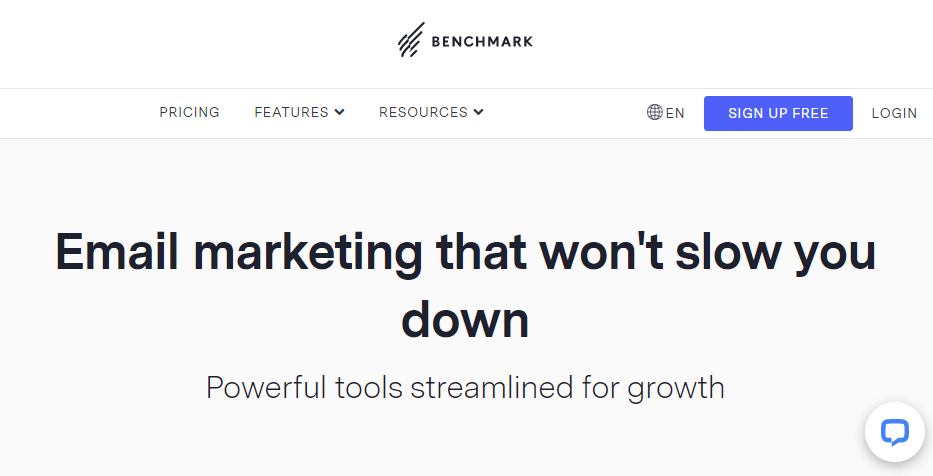
Benchmark Email was founded in 2004 with the goal of providing its clients with easy email marketing. By providing a sophisticated set of integrated and automated solutions, this email service provider assists small companies in growing their engagement, audience, and income.
Benchmark Email’s feature set is very remarkable, and the UI is simple and straightforward. Benchmark places a high premium on design, and their email designs are absolutely breathtaking. The drag-and-drop email editor is fantastic, greatly simplifying the process of editing emails.
Additionally, their tracking reports are sufficiently comprehensive. Users may track the success of their campaigns using data such as the number of emails opened, the open rate, the number of unopened emails, the number of links visited, the number of unsubscribes, and the number of forwarded emails.
In terms of autoresponder tools, Benchmark’s free plan includes a feature dubbed ‘Automation Lite.’ Users may use this functionality to create simple autoresponders, forms, reports, and surveys.
Automation Lite enables users to build a welcome email series and other very basic autoresponder sequences. To build more sophisticated automations, users must subscribe to a premium subscription. Users on the Pro plan may build automations for anniversaries, engagements, birthdays, and reminders.
However, the autoresponder editor is not particularly intuitive. Users cannot configure autoresponder sending times and cannot see autoresponders as part of a workflow. Deliverability rates are also not particularly high.
Benchmark Email Primary Features:
- The email editor comes with a drag-and-drop interface
- The platform offers a code editor
- The platform offers autoresponders
- Email templates are included
- CRM integration is possible
- There are options for marketing automation
- A/B testing is allowed
- Drip campaigns are allowed
- Event management is possible
- Polls and surveys are included
- Popups and signup forms are available
- Campaign tracking is possible
- Customer journey funnels
- Analytics and detailed reporting available
Best Suited For:
Benchmark Email is best suited for non-profit organizations and SMEs.
Advantages of Using Benchmark Email:
- Benchmark features an easy-to-learn curve.
- The tracking reports for pre-defined email campaigns are exhaustive.
- Benchmark’s customer service is exceptional.
- Users have a number of options for segmenting their data and list.
- Benchmark’s paid plans are very reasonably priced.
- Benchmark’s automation capabilities are simple to use and comprehensive.
Disadvantages of Using Benchmark Email:
- Users on the free plan are limited to sending 250 emails each month, which is very restrictive.
- The email editor occasionally lags.
- Deliverability is not great, since emails often end up in the Promotions tab or in the Spam folder of Gmail.
- The choices for the registration form are restricted.
- Benchmark lacks a mobile preview option. Also, there is no landing page editor.
- Benchmark is not capable of integrating with Salesforce.
Benchmark Email Free Plan:
There is a free plan of Benchmark that offers the following:
- Unlimited contacts.
- 250 emails per month.
If these features are too restrictive for your needs, you must upgrade to a paid plan, the prices of which start at $13 a month.
#7. ConvertKit
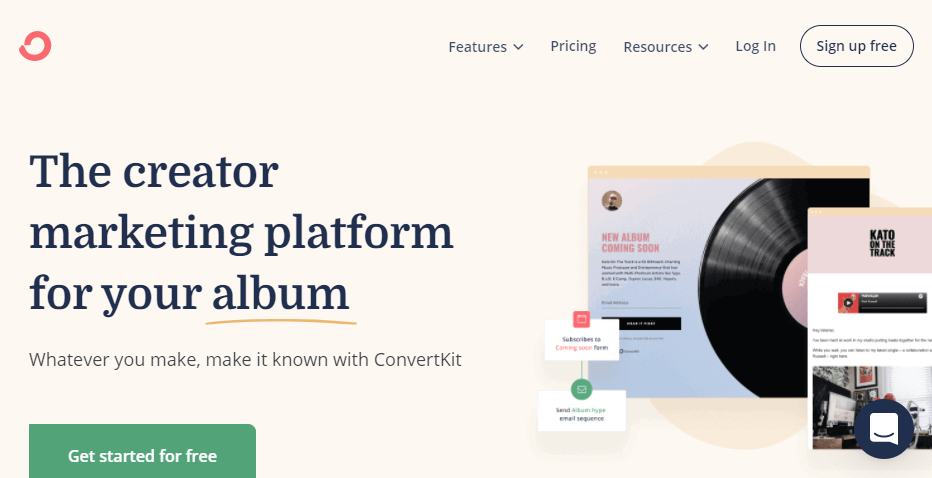
ConvertKit is a robust email marketing tool designed to assist online producers such as YouTubers, podcasters, bloggers, and freelancers in developing strong connections with their clients and/or audience. ConvertKit is very simple to use and has a plethora of capabilities. Users may use ConvertKit to build pop-ups and sign-up forms, as well as send customized emails to their subscribers and customers, and automate processes.
The autoresponder features of ConvertKit are excellent. Those features are designed for those who are not tech savvy. ConvertKit does this by simplifying the process of creating autoresponder series and automated workflows.
By choosing a condition, an action, or an event, users may begin creating sophisticated autoresponders. This involves adding and categorizing new subscribers, completing a form, and even making a purchase. If a user is unsure of the best route to take to achieve their objectives, ConvertKit provides automation templates. These templates cover topics such as holding a webinar, introducing a product, and following up with unpurchased consumers.
ConvertKit offers IFTT automation rules that users may utilize to build bespoke customer journeys. IFTT stands for “if this, then that.” Users may easily connect events, actions, and circumstances, and subsequent steps can be made to auto-populate to convert subscribers into customers.
ConvertKit Primary Features:
- A/B split testing is possible
- Analytics, detailed reports, and ROI tracking are all available
- Autoresponders are available
- Customizable CTA buttons
- Drip campaigns are possible
- Landing page builder is available
- Offer exceptional customer support
- Options for marketing automation are available
- Provides support for digital product sales and subscription
- Subscriber management is available
- Tagging system and segmentation is possible
- The platform offers a WYSIWYG email editor
- The platform supports automated funnels and sequences
- There are email templates and landing page templates available
Best Suited For:
ConvertKit is best suited for YouTubers, musicians, artists, bloggers, and other content creators. It is also best for SMEs.
Advantages of Using ConvertKit:
- ConvertKit is a straightforward and simple-to-use application.
- Duplicate subscribers are not charged by ConvertKit.
- ConvertKit offers exceptional automation capabilities.
- Users may build several forms to capture leads with varying incentives.
- ConvertKit provides an excellent method for delivering opt-in incentives.
- Users may create accounts in a matter of minutes and immediately begin creating landing pages and/or forms.
- Users may categorize and tag subscribers in a variety of ways.
- The editor for landing pages is simple to use.
- ConvertKit easily connects with membership websites and platforms such as WordPress and Teachable.
Disadvantages of Using ConvertKit:
- ConvertKit is not designed for integrating with e-commerce platforms
- ConvertKit is unable to do autoresponder testing on emails.
- The A/B testing functionality is now restricted to subject lines only.
- The email templates and landing page templates are limited in terms of versatility and modification.
- Users on the free plan are unable to utilize the automation features. They must upgrade to the premium plan in order to do so.
ConvertKit Free Plan:
The free plan of ConvertKit is available to anyone who wishes to use it. It offers the following:
- Up to 1000 subscribers.
- Unlimited forms and landing pages.
- Selling subscriptions & digital products.
In case you are looking for automated funnels & sequences, advanced reporting, and other advanced features, you must upgrade with one of their two plans that begin at $29 a month.
#8. AWeber
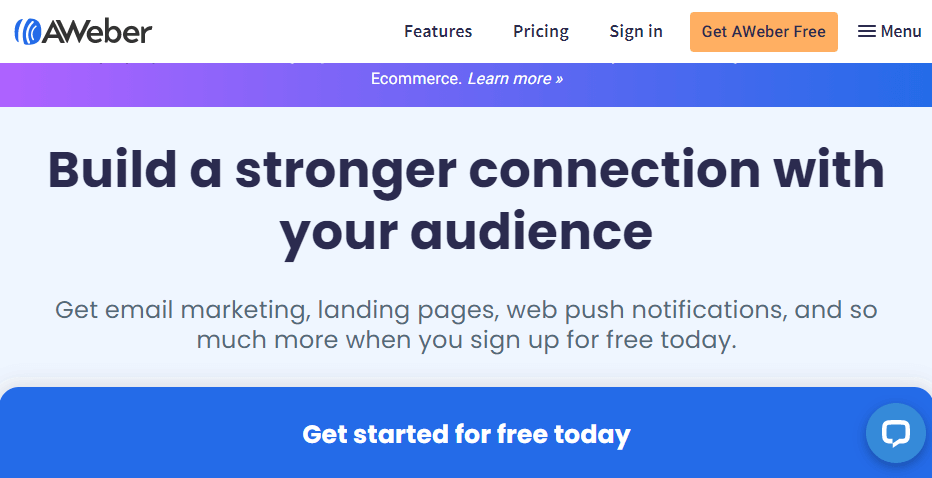
AWeber is among the oldest email marketing platforms available, having been founded in the year 1998. The platform is trusted by over 100,000 entrepreneurs and companies. They pride themselves on being user-friendly, which makes them ideal for small companies and start-ups. Additionally, they claim to have invented the autoresponder, which is quite an accomplishment.
AWeber’s templates are one of its most impressive features. AWeber provides more than 700 e-newsletter templates, all of which are responsive. The collection is, without a doubt, much more than the most, if not all, of its rivals.
As with autoresponders and automations, AWeber enables users to build automations via the use of custom rules. Users may send up to 3,000 emails each month via an autoresponder series, which is rather impressive. AWeber simplifies the process of setting up follow-up emails depending on time intervals.
Users may establish objectives and/or combine them with rules for automation to build complex autoresponders using AWeber. Additionally, users may use IFTT-style processes to build simple drip campaigns and sophisticated customer journeys. Users may create flowcharts that dictate when and how their emails are delivered in response to consumer activities like website visits, clicks, email opens, and sales.
The choices for triggering autoresponders in response to these user activities, on the other hand, are rather restricted. There are just two triggers available to you:
- whenever a contact is subscribed to a list.
- whenever a tag is applied.
Additionally, the nomenclature is perplexing, since both autoresponders and automations are referred to as AWeber Campaigns.
AWeber Primary Features:
- The email builder has a drag-and-drop interface
- A massive collection of responsive templates
- Options for marketing automation are available
- Email templates are all responsive
- Autoresponders are available
- Allows importing email lists
- Allows performing A/B split testing
- RSS/blog-to-email functionality is available
- Landing pages are available
- Offers 6000+ stock photos
- List segmentation is allowed
- Offers integrations with third-party apps
- Offers support via live chat, phone, and email.
Best Suited For:
AWeber is best suited for startups and SMEs.
Advantages of Using AWeber:
- AWeber is among the oldest email service providers (ESPs) and currently offers one of the finest free email autoresponder solutions available.
- The free version includes all features available in the premium plans.
- Users are allowed to import existing mailing lists in a variety of different file formats (CSV, TXT, XLS, XLSX, and TSV). Additionally, users may immediately add the email addresses of contacts imported to an autoresponder cycle.
- AWeber provides customers with robust categorization and automation capabilities for creating comprehensive autoresponder series.
- AWeber provides all support resources, including masterclasses and live webinars, to free plan subscribers.
- AWeber integrates with leading third-party applications such as PayPal, Unbounce, and OptinMonster.
- AWeber releases new features on a regular basis and makes them accessible to all users, even those using AWeber’s free plan.
- AWeber supports AMP email.
Disadvantages of Using AWeber:
- AWeber’s free trial period is just 30 days, which is insufficient time for customers to begin earning money from their email lists.
- AWeber may be very costly.
- The free plan has a cap of 500 subscribers, which is very low.
- AWeber charges users for subscribed as well as unsubscribed contacts, until unsubscribed contacts are deleted.
- A/B split testing is not available in the landing page builder.
- When sending an e-newsletter, users are not allowed to include or omit several parts simultaneously.
AWeber Free Plan:
AWeber has a free plan available that offers the following:
- One email list profile with maximum 500 subscribers.
- 3000 emails per month.
If that is not sufficient for you, you can upgrade to their Pro plan that costs $16.15 per month for maximum 500 subscribers. It can quickly get pricey as the subscriber count increases.
Okay, now that you have learned about the list, you can either stop here and exit the page, or you can continue reading to find the answers to some of the most important questions about autoresponders and email marketing in general.
Autoresponder FAQ
An autoresponder is a predetermined, automatic email that is sent in response to a specified set of criteria and circumstances, such as a time interval or a visitor action such as email open, a link click, or a page view. This kind of software is used to send email messages to leads who are on the verge of conversion. Depending on the chosen trigger and your set objective, autoresponder messages may be delivered as a single email or as a series of emails.
The following are justifications for using an autoresponder tool:
Customizable processes that target visitors depending on how they found your website.
Provide alternatives for automated SMS and chat.
Contact management segmentation and personalisation.
It includes statistics and reports that enable you to see the success of your automation campaigns and emails.
Provides automation specific to eCommerce needs, including abandoned cart notifications.
Offers landing pages that assist you in increasing the likelihood of acquiring new subscribers.
When choosing an email marketing service, you must take the following factors into account:
Template: The email template is the most critical component of email marketing. As a result, you need an email service provider that enables you to swiftly and effortlessly compose simple, beautiful emails.
Tracking: Additionally, you should ensure that your email provider offers a unified dashboard showing all the necessary data. For instance, unsubscribers, open rates, clicks, bounces, as well as a social sharing option.
Automation: You need to provide the most relevant information to the appropriate people at the most appropriate time, and automation enables you to do it conveniently. As a result, you must ensure that your email service provider has robust processes for scheduling and sending automated messages.
Mobility: Your emails should be compatible with the different devices used to consume email. Today, email marketing focused on mobile devices are increasingly popular. Your email should be compatible with both iOS and Android devices. Otherwise, you will be losing conversions and money.
Customization: You should have the ability to modify and adjust every aspect of an email template in order to create a really customized message.
Drag-and-drop editor: Choose an email service that has a drag-and-drop editor that enables you to easily add white space, pictures, text, and social symbols.
Define your budget: The last, but perhaps most critical factor to consider when choosing an email service provider for your marketing needs is your budget. You may choose from low-cost, medium-cost, and enterprise-level suppliers. By selecting the appropriate one for your requirements, you may save costs while maintaining functionality.
Send Time Optimization is a data-driven technique for determining when your contacts are most likely to interact and then sending your email marketing communications at that time.
The following are critical points to consider before beginning this process:
Depending on your plan, you may be unable to use Send Time Optimization. To begin, you need to understand which features are included in each of your autoresponder tool’s plans.
Send Time Optimization, for example, may be used with Mailchimp’s standard, A/B testing, multivariate email, and plain-text email kinds. This functionality is not accessible, however, for automated emails.
The CAN-SPAM Act is a cyber legislation that establishes standards for commercial emails, provides recipients with the opportunity to opt out of future emails, and imposes severe penalties for violators.
It does not, however, apply only to bulk emails; it also applies to commercial communications, which the law describes as “any email message.” This law’s main objective is to provide guidelines for commercial advertising and promotion of a commercial service or product.
Additionally, it contains Email, which is used to advertise content available on commercial websites. The legislation provides no exemption for business-to-business correspondence. For instance, a letter sent to previous clients informing them of new services or product lines must adhere to the legislation.
